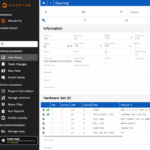Here is the second script for your perusal (the first is here, and the third will be posted asap).
Panic Hardware Styles and Types [Draft Script]
Whether panic hardware is required by code or specified for increased security and ease of use, there are three basic styles and four types that are commonly used.
The style of panic hardware selected is dependent on aesthetic requirements, door design, and a few other factors.
- The touchpad style is the most common style used for modern buildings and allows flexibility when electrified options such as electrified lever trim, electric latch retraction, delayed egress, or controlled egress are required.
- The crossbar style is often used when aesthetics dictate a minimal silhouette for glass doors, or a vintage look, but electrified options are sometimes limited because of the lack of space in the device to house electronic components. The width of a door’s vertical stiles must be considered when specifying or supplying touchpad or crossbar style panic hardware.
- Recessed panic hardware reduces the projection of the hardware from the face of the door, but requires a cut-out in the door and may limit the door material to hollow metal.
After the style of panic hardware is selected, one of the four common types of panic hardware is chosen for each door opening, based on functional requirements and whether the door is a single or a pair.
- A rim panic device is surface-mounted on the door, with the latch projecting from the panic device rather than the door edge. This is the simplest configuration of panic hardware, and the easiest to maintain. Rim panics can be used on single doors, or on pairs of doors in conjunction with a removable mullion. The rim x rim x removable mullion is a very secure application for pairs of doors, because the alignment of the doors is less critical than it is with vertical rod devices. A key-removable mullion makes the mullion easy for authorized users to remove when the full width of the opening is needed.
- A mortise panic device has a mortise lock body which is installed in the door, with the panic hardware mounted on the door face but controlling the mortise lock. Mortise panics are less commonly used than rim panics, likely because of the more complex door preparation and product design. For fire rated pairs with a 3-hour label, mortise fire exit hardware is sometimes used in conjunction with vertical rod fire exit hardware on the other leaf, but some manufacturers have successfully tested their products for 3 hours with vertical rod fire exit hardware on both leaves or rim devices with a removable mullion.
- A vertical rod device would typically be used for pairs of doors, and the rods and latches may be surface-mounted on the face of the door, or concealed inside of the door. For concealed applications, there is panic hardware available which incorporates cables instead of rods, for easier installation and maintenance. Vertical rod fire exit hardware is sometimes installed “less bottom rod” (LBR), which allows floor strikes to be omitted along with the bottom rods and latches. An auxiliary pin is typically required for LBR devices to ensure compartmentalization if a fire occurs. This pin is held in a retracted position in the door edge until it reaches a high temperature during a fire, and then it projects automatically to align the doors and protect the opening.
- A multi-point device combines vertical rods or vertical cables and a rim device, for 3-point latching. These may be used for security purposes, or to meet windstorm requirements.
All of these styles and types are available as panic hardware, listed for use on non-fire-rated egress doors, and fire exit hardware – listed for use on fire-rated egress doors. Additional options for panic hardware include the finish, the type of dogging, electrified options, and trims and controls.
- Panic hardware is available in a variety of finishes, including architectural plated finishes, stainless steel (when the base material is stainless steel), and powder coat finishes – both standard and custom colors.
- The act of dogging a panic device holds the latch or latches retracted to allow the door to operate as a push-pull function. This saves wear and tear on the hardware, and makes it easier for building occupants to use. Dogging options include hex-key or key cylinder dogging, and electric latch retraction may also be used to dog a panic device. For fire exit hardware, mechanical dogging is not allowed, but the latch may be dogged electrically if it projects automatically during a fire to provide a positive latch.
- Many electrified functions are available for panic hardware, including electric latch retraction, electrified lever trim, delayed egress, controlled egress, alarms, switches, or other electrified options to meet the access control and monitoring needs of the facility.
- There are several other videos in this series that address panic hardware, including the applicable code requirements and the available trims and controls.
You need to login or register to bookmark/favorite this content.





Mention UL 305?
Check the panic hardware may look like panic hardware but is not such as some detex or trident ??
Regarding the aux pins on LBR devices. Some wood door manufacturers require two pins – one into the door jam and one into the floor. The one in the floor would then have all the problems associated with a floor strike – dirt filling and “What is that for?”
Hi Jack –
Sorry for the delay – I’ve been traveling and my inbox got backed up. When we supply the auxiliary fire pin for edge-of-door installation, the “strike” is just a hole in the door that has a cover that is plastic or some other plastic-like material. I have not seen a different strike offered for the floor, so maybe the same plastic cap is used? This would solve the dirt-collection problem but I don’t know how well it would wear. I know some door manufacturers have tested their products this way, but I haven’t actually seen one installed.
– Lori
For crossbar style panic, also consider how the projected hardware could reduce exit width below code minimum. A standard 36″ door minus 1-3/4″ door thickness minus 3-3/4″ projection (for Von Duprin 55) = 30.5″, less than typical 32″ minimum width.